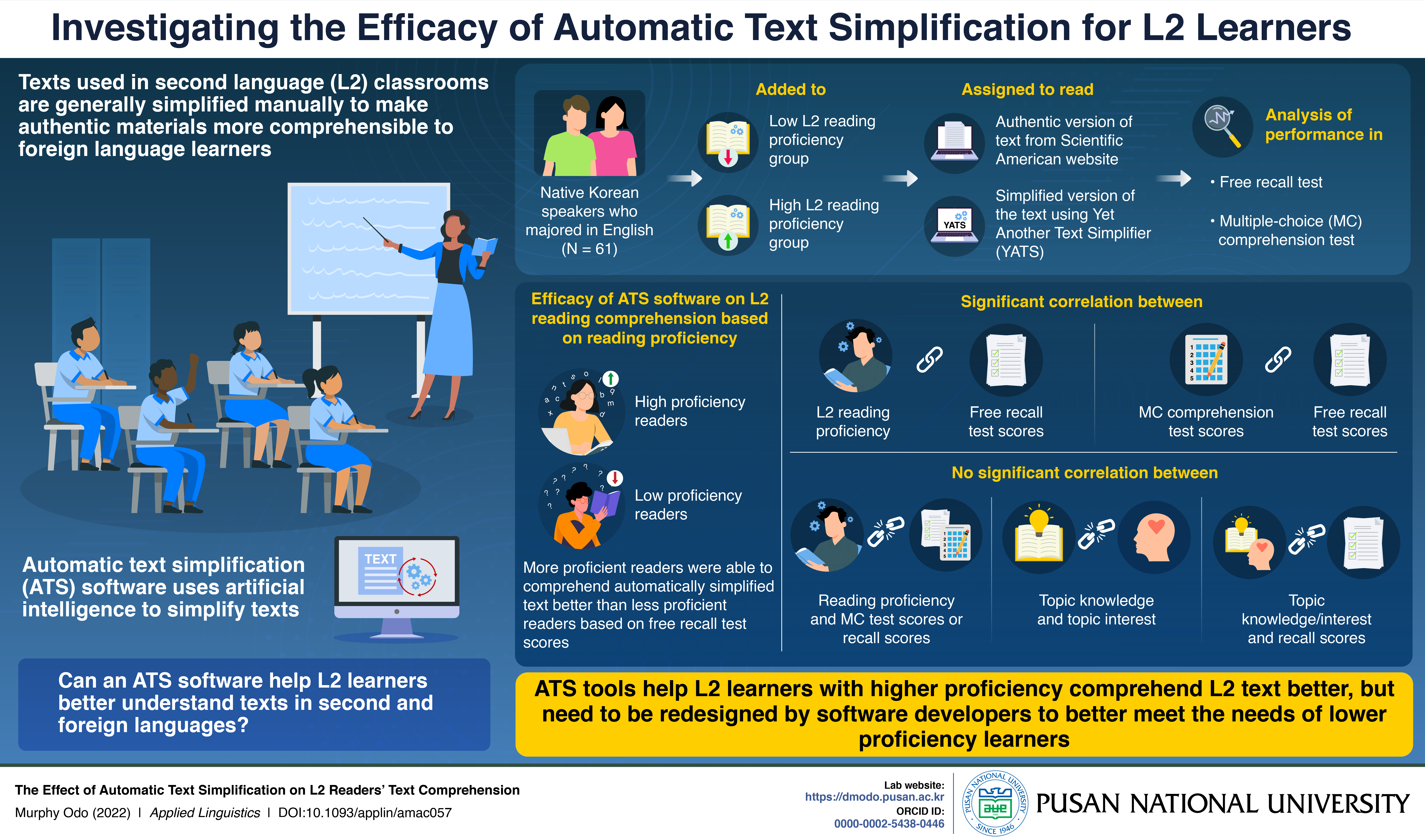
Automatic Text Simplification: Efficacy in the Foreign Language Classroom
New study finds AI-enabled automatic text simplification makes foreign language text comprehensible
for foreign language learners with high reading proficiency
Texts used in second language (L2) classrooms have traditionally been simplified manually. With recent technological advances, text can be simplified automatically through artificial intelligence-enabled software. A new study investigated the effectiveness of an automatic text simplification (ATS) software and found that it made text comprehensible for L2 learners with a certain level of reading proficiency, highlighting the need for additional development of these tools for them to become effective for all learners.

Image title: Efficacy of Automatic Text Simplification in Making Foreign Language Text Comprehensible for L2 Learners
Image caption: A new study found that automatic text simplification made English text more comprehensible for second language learners beyond a certain level of reading proficiency
Image link: N/A
Image credit: Dennis Murphy Odo from Pusan National University
License type: Original content
For students learning a second or foreign language, text is often simplified to ensure that they can comprehend it well enough to understand the core message. Usually, complicated text in a foreign language is simplified manually by teachers or material designers. However, with the advent of artificial intelligence (AI)-based software, automatic simplification of text is now a reality. One such tool is the automatic text simplification (ATS) software, which simplifies text in second and foreign languages for L2 learners. Currently, there is limited data on the effectiveness of an ATS software in an educational setting.
To address this, Professor Dennis Murphy Odo from the Department of English Education at Pusan National University conducted a study, published in Applied Linguistics, to assess how L2 learners comprehend English language text simplified by an ATS tool. For this purpose, he recruited 61 native Korean speakers who had been studying English for the past 10 years, with reading proficiencies ranging from low to high.
These L2 learners were divided into low and high L2 reading proficiency groups and assigned to read either authentic English text derived from the Scientific American website, or automatically simplified version of that same text using a ‘Yet Another Text Simplifier’ (YATS) ATS tool. Following this, the L2 learners from both groups took a free recall test and a multiple-choice (MC) comprehension test, that tested their ability to recall and comprehend the text.
The key finding, derived from an analysis of the free recall test scores was that L2 learners with a higher reading proficiency found automatically simplified text more comprehensible, as compared to L2 learners with a lower reading proficiency.
While discussing this finding Prof. Odo remarks, “Although online automated text simplification tools can prove to be highly useful in making authentic materials more comprehensible for L2 learners beyond a certain level of foreign language reading proficiency, they may not do so for learners with a lower level of reading proficiency.”
Hence, ATS software can help L2 students with a high reading proficiency understand complicated text, and support teachers in simplifying challenging text for their students.
However, there is a need for ATS tools to be developed further, in order to make text comprehensible enough for L2 learners with low reading proficiencies. “On the positive side, software developers will continue to develop AI-enhanced tools that will make challenging texts more and more comprehensible to foreign language learners with different reading proficiencies,” says Prof. Odo in conclusion.
Reference
Author: Dennis Murphy Odo
Title of original paper: The Effect of Automatic Text Simplification on L2 Readers’ Text Comprehension
Journal: Applied Linguistics
DOI: 10.1093/applin/amac057
Affiliations: Pusan National University
About Pusan National University
Pusan National University, located in Busan, South Korea, was founded in 1946, and is now the No. 1 national university of South Korea in research and educational competency. The multi-campus university also has other smaller campuses in Yangsan, Miryang, and Ami. The university prides itself on the principles of truth, freedom, and service, and has approximately 30,000 students, 1200 professors, and 750 faculty members. The university is composed of 14 colleges (schools) and one independent division, with 103 departments in all.
Website: https://www.pusan.ac.kr/eng/Main.do
About the author
Professor Dennis Murphy Odo received his Ph.D. in Language and Literacy Education and has served as an in-service public school TESOL methods teacher trainer for the Korean Ministry of Education. He has also worked as an Assistant Professor of reading education at Georgia State University where he taught courses in first and second language reading. He is currently a professor at the Department of English Education at Pusan National University, where he teaches courses in second language acquisition and literacy instructional methods. His main research interests include learner autonomy, technology, second language literacy instruction, and teacher development.
ORCID ID: 0000-0002-5438-0446
Personal website address: https://dmodo.pusan.ac.kr
Email address: dmodo@pusan.ac.kr

 PURCS_67_Infographic_final.png
(2MB)
PURCS_67_Infographic_final.png
(2MB)